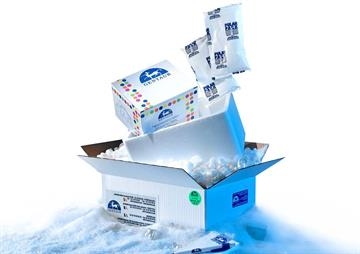MIP-1 beta Recombinant Protein

MIP-1 beta Recombinant Protein
785.65 €
In Stock
quantity
product details
Catalog number: 223 - 40-365-001mg
Product Category: Business & Industrial > Science & Laboratory
ProSciGentaur
Size: 0.01 mg
Related Products
PROTP26889
IL-1-beta Interleukin-1 beta Porcine Recombinant Protein
Recombinant IL 1 beta Porcine produced in E.coli cells is a non-glycosylated, homodimeric protein containing 153 amino acid chain and having a molecular mass of 17.6kDa. The IL 1 beta is purified by proprietary chromatographic techniques.
525 €
PROTQ28386
IL-1-beta Interleukin-1 beta Equine Recombinant Protein
Recombinant IL 1 beta Equine produced in E.coli cells is a non-glycosylated, homodimeric protein containing 153 amino acid chain and having a molecular mass of 17.3kDa. The IL 1 beta is purified by proprietary chromatographic techniques.
720.6 €
PROTQ63264
IL-1-beta Interleukin-1 beta Rat Recombinant Protein
Interleukin-1b Rat Recombinant produced in E. coli is a non-glycosylated, Polypeptide chain containing 153 amino acids and having a molecular mass of 17.3 kDa. The IL-1b is purified by proprietary chromatographic techniques.
525 €
100-187S
Human Heregulin beta-1 Recombinant Protein
Neuregulin/Heregulin is a family of structurally related polypeptide growth factors derived from alternatively spliced genes (NRG1, NRG2, NRG3 and NRG4). To date, there are over 14 soluble and transmembrane proteins derived from the NRG1 gene. Proteolytic processing of the extracellular domain of the transmembrane NRG1 isoforms release soluble growth factors. HRG1-β1 contains an Ig domain and an EGF-like domain that is necessary for direct binding to receptor tyrosine kinases erb3 and erb4. This binding induces erb3 and erb4 heterodimerization with erb2, stimulating intrinsic kinase activity, which leads to tyrosine phosphorylation. Although HRG1-β1 biological effects is still unclear, it has been found to promote motility and invasiveness of breast cancer cells which may also involve up-regulation of expression and function of the autocrine motility-promoting factor (AMF). Recombinant human Heregulin-β1 (HRG1-β1) is a 7.5 kDa polypeptide consisting of only the EGF domain of heregulin-β1 (65 amino acid residues).
438.6 €
400-001
Human IL-1 beta Recombinant Protein
Interleukin-1 beta (IL-1beta) is produced by activated macrophages. IL-1beta stimulates thymocyte proliferation by inducing IL-2 release, B-cell maturation and proliferation, and fibroblast growth factor activity. IL-1beta proteins are involved in the inflammatory response, being identified as endogenous pyrogens, and are reported to stimulate the release of prostaglandin and collagenase from synovial cells. IL-1 is a name that designates two pleiotropic cytokines, IL-1 alpha (IL1F1) and IL1 beta (IL1F2), which are the products of distinct genes. IL- 1 alpha and IL-1 beta are structurally related polypeptides that share approximately 21% amino acid (aa) identity in human. Both proteins are produced by a wide variety of cells in response to inflammatory agents, infections, or microbial endotoxins. While IL-1 alpha and IL-1 beta are regulated independently, they bind to the same receptor and exert identical biological effects. The human IL-1 beta cDNA encodes a 269 aa precursor. A 116 aa propeptide is cleaved intracellularly by the cysteine protease IL-1 beta converting enzyme (Caspase1/ICE) to generate the active cytokine. The mature human IL-1 beta shares 96% aa sequence identity with rhesus and 67% 78% with canine, cotton rat, equine, feline, mouse, porcine, and rat IL-1 beta. Human recombinant IL-1beta produced in E. coli is a non-glycosylated, IL-1 beta polypeptide chain containing 153 amino acids and having a molecular mass of 17.0 kDa.
370.88 €
400-002
Human IL-1 beta Recombinant Protein
Interleukin-1 beta (IL-1beta) is produced by activated macrophages. IL-1beta stimulates thymocyte proliferation by inducing IL-2 release, B-cell maturation and proliferation, and fibroblast growth factor activity. IL-1beta proteins are involved in the inflammatory response, being identified as endogenous pyrogens, and are reported to stimulate the release of prostaglandin and collagenase from synovial cells. IL-1 is a name that designates two pleiotropic cytokines, IL-1 alpha (IL1F1) and IL1 beta (IL1F2), which are the products of distinct genes. IL- 1 alpha and IL-1 beta are structurally related polypeptides that share approximately 21% amino acid (aa) identity in human. Both proteins are produced by a wide variety of cells in response to inflammatory agents, infections, or microbial endotoxins. While IL-1 alpha and IL-1 beta are regulated independently, they bind to the same receptor and exert identical biological effects. The human IL-1 beta cDNA encodes a 269 aa precursor. A 116 aa propeptide is cleaved intracellularly by the cysteine protease IL-1 beta converting enzyme (Caspase1/ICE) to generate the active cytokine. The mature human IL-1 beta shares 96% aa sequence identity with rhesus and 67% 78% with canine, cotton rat, equine, feline, mouse, porcine, and rat IL-1 beta.Human recombinant IL-1beta produced in E. coli is a non-glycosylated, IL-1 beta polypeptide chain containing 153 amino acids and having a molecular mass of 17.0 kDa.









